 |
firm active: 1907-1921 minneapolis, minnesota :: chicago, illinois |
Ye Olde Grindstone
4/15/2007
Fortunately and generously, a former employer
recalled me to their office and has made every effort to ensure that my life
gets up from the prone position where I have been gasping for air. I am
deeply grateful for this re-turn of events, but the change into being back
in a busy architectural office has also been something of a challenge.
Promising myself that I would remain healthy and deter a repeat visit to the
dark side of hypertension, I have been resting when tired--as I usually am when
I get home. Hence, I have had to let this web site and all the others I
maintain simply take rest alongside. Our Caravan is indebted to Susan O'Connor, who
contributes the adjacent photograph of this Purcell, Feick & Elmslie
apartment building in Chicago. Located just two blocks from the Robie House
in the Hyde Park neighborhood, Susan's research showed that the
Apartment Building for H. H. Newman and G. L. Marsh
was even nominated in 1973 for the National Register. Further, it appears in
the Chicago Landmarks Historic Resources Survey, deemed "Too altered for
architectural or historic significance." What news to me that it was built
at all! Aside from the four sketches in the P&E
archives, there was just one other scrap of paper to indicate anything had
ever been built. A small, approximately six inch square sawed wood diagram exists in the
Purcell Papers, marked with this job number. Given there were no working
drawings, specifications, or any design development documents at all, we
took the best guess that the diagram might have been mislabeled in the
1950s, as sometimes things were from time-dimmed memory. Oops. My recent search of the P&E
office correspondence yielded a single letter from Elmslie to the "Citizens"
of the Minneapolis office recounting a meeting with the University of
Chicago professors who were striving to supplement their non-tenured
positions with a little land development income. Elmslie reported that these
gentlemen were uncertain of the investment capital, and as yet I have found
no further mention of the project in subsequent communications. I must mention that during these past
months I had the delight of a visit with John Panning, proprietor of
The Prairie
School Traveler website. I think I need to get out more. His kind
comments about this site are a heartening encouragement to continue in what
has been, sometimes, a lonely journey. I yapped endlessly in joy of a fellow
Traveler in the Caravan being present.
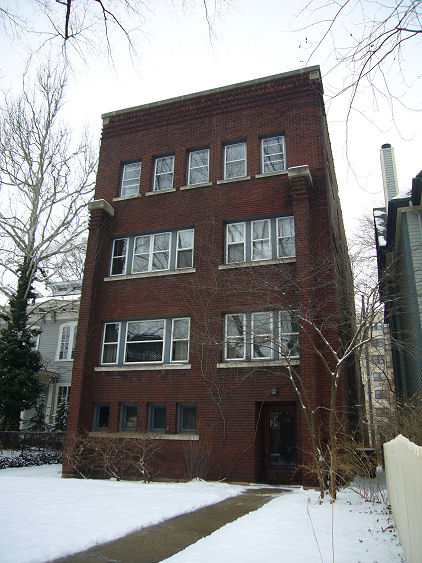
Apartment Building for H. H. Newman and G. L.
Marsh
Purcell, Feick and Elmslie
Chicago, Illinois 1913
Photograph courtesy Susan O'Connor
Wonder of wonders. Before I start this long belated update, a word
of thanks to those who have inquired of my wellbeing after such a lengthy
lapse here. I have appreciated the concern. As everyone who reads these
notes can learn, my financial condition was unsteady for many months
following a reminder of my mortality, one that occurred without health
insurance. While I have been blessed with many helpful friends whose
proactive assistance got me through that tough eighteen month period, the
reality is that I need to be able to bring income through the door in order
to keep it in place--kind souls notwithstanding.
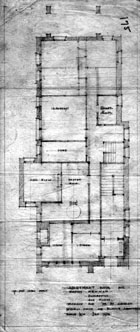
Floor plan
Source: Images, University of Minnesota
Libraries
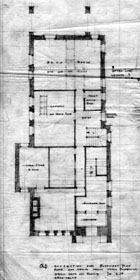
Floor plan
Source: Images, University of Minnesota
Libraries
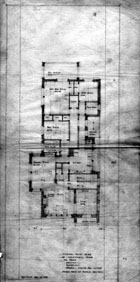
Floor plan
Source: Images, University of Minnesota
Libraries
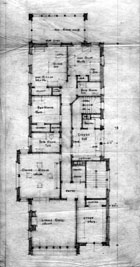
Floor plan
Source: Images, University of Minnesota
Libraries
Note how the facade piers shift around from sketch to sketch, and are all different
from the realized structure.
When the P&E commission list
was compiled in 1982 for the Guide to the William Gray Purcell Papers, the
materials in the job files (shelf boxes and drawing flat files) were used to
determine whether projects shown on the original 1910s list typed by P&E
secretary Gertrude Phillips were unrealized designs or had actually been
built. This product was cross referenced with publications or research
manuscripts by architectural historians, principally those of H. Allen
Brooks and David Gebhard. That was the best available information.

Sawed wood diagram
Apartment Building for H. H. Newman and G. L.
Marsh
Purcell, Feick and Elmslie
Chicago, Illinois 1913
Source: Images, University of Minnesota
Libraries
That brief note must do for revival, as my
efforts are called to give CPR to other areas also gone fallow. While I do
look forward to winning the lottery and/or marrying into money, for the time
being my contributions here are back on track with whatever merit my own
efforts can bring to bear. Thanks again to everyone who sent good wishes my
way.
3/24/2007
Alas. Paint stripper and some bits of wood are
needed to set this right, but it's a long drive to Home Depot, apparently.
And to think that in the 1970s this little banking institution prided itself
on keeping up what they could. Even with new construction
hitting the emergency brake and the pipers lining up to be paid for the
piranha frenzied engorgement by corporate banks on the greased sleaze of
sub-prime lending, people deterred from moving site altogether will still
seek "improvements" (a technical term used by building departments to
indicate change, purely in the sense of amendment, to a property; only the
hopefulness of language implies intrinsic betterment as a result). As
they have been for years now, architects are overloaded with work.
Competition for a good set of helping hands is stiff. This is true both for
what are euphemistically called "production offices," meaning firms that
crank out boilerplate drawings for strip malls, fast food restaurants, and
cookie cutter residential subdivisions, and those firms, large and small,
who want to actually practice architecture by adding some sort of design
value, with whatever degree of commitment to principle and expression of
talent they can muster. Of course, architects that
work within a particular vein of practice like organic design are fishing in
an even smaller pond. CAD crews in Indonesia or Malaysia that can knock out
a set of construction drawings for a 10,000 square foot faux Spanish Revival
or Tuscan villa at twenty four hours notice and a charge of $20,000
(invisibly marked up by the American architect to $60,000 for the client) are not
going to work out well for firms dealing with uniquely expressive forms
related to local site, client, and circumstance. Such is yet another trench
in the hoary battle between historical revivalism and honest indigenous
architecture, this time bent into the pretzel of globalization. Small
stateside firms, whether yacht or dinghy-like, have to contend with the deep
pockets of supertanker-sized enterprises that can afford to sweeten the
dogged bitterness of soul-less design with high end medical, dental, and optical
insurance, 401K plans, four weeks of paid vacation a year to start, and
maybe a signing bonus or relocation package worth two or three months of
salary. The annual cost to a firm for even a minimally skilled CAD drafter
starts at $60,000 and goes up rapidly, particularly if the candidate happens
to work with the right CAD software package (AutoDesk dominates PC platforms like tuna in
a can but there are boutique programs such as VectorWorks and ArchiCad for
those who want salmon or smoked oysters with their Apples). What, you may ask, could
such present day hiring dilemma have to do with Purcell & Elmslie? Are we
off on another one of those goofy grinds, like the one that discussed
real phasers and
teleportation (and generated more email from readers than most)? No,
indeed. What could be more relevant than the effort to recruit members of
the Team? Even without computer-aided graphics being in the mix, it could be
hard to get someone into the office who had that special mental hook
required for mutual benefit in the process of progressive design. The
successful candidate for the position at my office, for example, will have
to fit comfortably with an approach to design derived from over a decade of
association by the senior principal with Frank Lloyd Wright (as well as be
VectorWorks proficient). Where and how, we may wonder, could P&E have looked
for people similarly already in the mix? By George, I
think he got it. As it happens, there were
two places. One of them was the same tank, Frank Lloyd Wright's
establishment at Taliesin. In fact, after surviving the murders and fire
there in 1914, Wright's drafter Herbert Fritz asked for work at P&E and was
immediately hired. The other place, naturally, was the office of Louis
Sullivan. This brings us to the touchy business of what has to be called
plainly for what it is, the poaching of able bodies. Most architects have a
certain deportment amongst themselves, however thin the patina may be, that
bears itself in words and ways which would never, ever be seen (in
the sense of getting caught) shoplifting studio help. Nonetheless, drafters
no matter how gainfully employed can develop a certain undercurrent of
dissatisfaction in their situations, often from brooding over various real
or imagined slights of being underappreciated, disregarded without proper
acknowledgement, or taken for granted. This can lead to conversations and
correspondences that vibrate through the network of their peers, and attract
the attentions of other architects like spiders tending to their webs. Thus we arrive at an
interesting case study. Over the first four months of 1911, Mssrs. Purcell
and Elmslie attempted, jointly and ever so delicately, to leverage
Parker N. Berry out of Sullivan's office in
Chicago and into their own fold in Minneapolis. The first in
a series of
letters shows this to have been a happy aspiration on the part of Parker
Berry, one given hope by an initial conversation with Purcell. After
navigating the shoals of self-esteem and putting a price on himself, Parker
gets the offer he wanted. There are seven letters in the sequence, six of
which are now
posted. The last one from Elmslie is taking a LONG time to decipher. Worse, whoever wrote
the description for the sale catalog really ought to know better. While
I read most everything that comes to my eyes on P&E and sometimes
disagree for reasons of opinion, in all my years in the Caravan I have
never seen such a ridiculous and malformed statement pretending to be
fact about anything P&E as accompanies this sale. After regurgitating
the obligatory introductory truths, whoever penned this takes a flying
leap into an abyss of pretension, heedless of everything that
is documented about this chair form (underlined below):
Sofa and two chairs (reupholstered,
badly) "The Minneapolis-based architectural firm
of Purcell, Feick and Elmslie was one of the leading proponents of the
Prairie School style. In addition to being distinguished for their
residential commissions, the firm designed a large number of banks
throughout the Midwest. Their bank buildings demonstrated a new and
progressive architectural vocabulary distinguished by box-like structures,
steel frames, brick facades, stylized terracotta ornament, pier-and-lintel
framing, arched entries, and integrated interiors. The sofa and arm chairs
in the current lot follow the 1912 design for the Merchants Bank of Winona,
the firms most celebrated bank commission. In addition to the architectural
plan, the firm provided designs for all aspects of the interior, including
leaded glass windows and a large sky light, grilles for the tellers,
lighting fixtures, and furniture. The progressive design of this seating
furniture is suggestive of the modular, geometric designs synonymous with
Austrian furniture of the period, notably by Koloman Moser. Purcells travels
abroad and exposure to Austrian design likely served as the inspiration for
these forms. Variations of this iconic chair design were also used in
the living room of Purcells own Minneapolis residence, the Edna S. Purcell
House, which was named after the architects wife." What utter rot, as an Englishman
might say. Or, perhaps, bollocks. Just call me Mark Quixote, I guess. While I
attribute the intellectual slag of the above underlined pronouncement to one
blinkered individual, I have only praise for
Sotheby's in general. I relish each new catalog I receive, and access to
their web site is a research paradise of educational images. If you haven't
signed up for a free account to get their emailings, you should give
yourself a gift. The "American Renaissance" is a periodic series of auctions
where objects from Frank Lloyd Wright, the Griffins, Maher, and P&E appear
with some regularity; some of these have already
been noted here on Organica. The Winona furniture is being offered in
"Fine 20th Century Design & An Important Private Collection of Art Deco
Figures" [Sale L07670] on May 2, 2007, as Lot 113, in London. Another reason
to look forward to coming into money, as if I
needed any more: I could rescue objects like this and send up a nice special
order to Garrett Leather. Coming up.
Due to the impetus of an archaeological dig
through a couple of my many storage boxes occasioned by the recent visit of
Prairie School Traveler John Panning, I am about halfway through an
inventory of my research materials. The Parker Berry letters turned up as
part of this process, wherein I am putting everything in protector sleeves
and thence into three ring binders (which the original P&E archivist John
Jager once remarked are "a mighty lever in the work of the historian").
Photocopies and not a few originals received as gifts from the Purcell
family and his surviving friends over the past twenty years have proven to
contain far more than I ever realized. A few years ago, as well, Bruce
Brooks Pfeiffer kindly sent me copies of a two inch thick pile of P&E office
correspondence and related documents not present in the Purcell Papers,
drawn from years of research by Bill Marlin before his death and including
more than a few letters by George Elmslie and a much suffering Alphonso
Ianelli about the Woodbury County Court House. There seems to be an
increasing momentum here, and for the foreseeable future such is likely to
form the content of the Grind. That, and I am finally getting through other
documents long stalled out in the typing queue. Looks like an update about
every two weeks is a good schedule. See you on May Day.

Detail, doorway
Exchange State Bank
Purcell, Feick and Elmslie
Grand Meadow, Minnesota 1910
Photograph by Tom Shearer, 2007

George Elmslie walking in, circa 1911. I
wonder if he was thinking about Parker Berry.
Source: Glass negative in the William Gray Purcell Papers, Northwest
Architectural Archives (two-fer, see ghostly child).
A Hunting We Will Go.
The architectural
firm where I rub-a-day to generate the money to keep serving this web site
is experiencing a problem endemic to the profession at the moment: filling a
drafter position. Prosecuting the personnel search falls to my lot in the
practical ways of placing ads, calling headhunters, and so forth. There are
dozens, if not hundreds, of available jobs in southern California
architect's (and engineer's) offices who are all seeking that extra set of
shoulders to lean into the workload. The business of architecture is
something like dentistry or, in some cases, a beauty salon. Regardless of
where things are in the economic cycle of life people always need, sometimes
desperately, such professional services. Time and materials continue to be
spent, as they ever are, on the built environment.
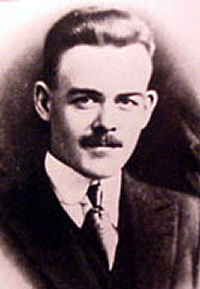
Parker Noble Berry
1888-1918

Interstate National Bank
Parker N. Berry, architect
Chicago, Illinois
Debris Washes Ashore.
Some of what is apparently the Merchants National Bank of Winona
furniture is up for auction at Sotheby's, although the sofa form is new
to me. The estimate runs from $10,000-$18,000, but the original rich
dark forest green leather is long gone. Whoever recovered the three
pieces (2 chairs and a sofa) could not have chosen a more inappropriate
and ugly color, at which misjudgment one can only shudder.

Merchants National Bank
Purcell, Feick, and Elmslie
Winona, Minnesota 1912
Source: Sotheby's
![]() research courtesy mark hammons
research courtesy mark hammons